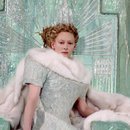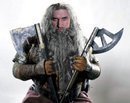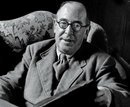David C. Downing's Blog, page 14
October 30, 2011
In LOOKING FOR THE KING, set in 1940, the two young Americans visit Gosforth Cro...
In LOOKING FOR THE KING, set in 1940, the two young Americans visit Gosforth Cross, looking for clues about the Spear of Destiny. Dating back to before the Norman Conquest in 1066, the cross depicts scenes from Norse mythology on three sides, all wolves and serpents and horsemen. But the east face seems to portray the Crucifixion, with the Roman soldier piercing Christ's side with a lance. There's a wooden replica of the stone cross inside the church (in Gosforth, Cumbria). What do you think? Is this a Crucifixion scene or some incident from Norse mythology?

Wall Photos

Wall Photos
Published on October 30, 2011 08:58
October 29, 2011
In LOOKING FOR THE KING, two young Americans are looking for the Spear of Destin...
In LOOKING FOR THE KING, two young Americans are looking for the Spear of Destiny in England in 1940. Wikipedia claims that both Napoleon and Hitler sought this spear, the fabled lance that pierced the side of Christ. Anyone know of a scholarly source to confirm this? (Not Trevor Ravenscroft's book--it's full of errors and fanciful speculations.)

Wall Photos

Wall Photos
Published on October 29, 2011 07:35
October 27, 2011
INKLINGS Q & A: Silmarils, radiant jewels; Anduril, Aragon's sword; Mithril, Fro...
INKLINGS Q & A: Silmarils, radiant jewels; Anduril, Aragon's sword; Mithril, Frodo's elvish underarmor. All end in -ril. Coincidence? (Not if you know Tolkien!)
A: In Tolkien's invented language, Quenya, -ril means "sparkling, brilliant." Silmaril = shining sparkle; Anduril = long & brilliant; mithril = sparkling grey. ("Mith" also shows up in Mithrandir, "Grey Rider," a name for Gandalf.)

Wall Photos
A: In Tolkien's invented language, Quenya, -ril means "sparkling, brilliant." Silmaril = shining sparkle; Anduril = long & brilliant; mithril = sparkling grey. ("Mith" also shows up in Mithrandir, "Grey Rider," a name for Gandalf.)

Wall Photos
Published on October 27, 2011 11:58
INKLINGS Q & A: Silmarils, radiant jewels; Anduril, Aragon's sword; Mithril, Fro...
INKLINGS Q & A: Silmarils, radiant jewels; Anduril, Aragon's sword; Mithril, Frodo's elvish underarmor. All end in -ril. Coincidence? (Not if you know Tolkien!)
A: In Tolkien's invented language, Quenya, -ril means "sparkling, brilliant." Silmaril = shining sparkle; Anduril = long & brilliant; mithril = sparkling grey. ("Mith" also shows up in Mithrandir, "Grey Rider," a name for Gandalf.)
[image error]
Wall Photos
A: In Tolkien's invented language, Quenya, -ril means "sparkling, brilliant." Silmaril = shining sparkle; Anduril = long & brilliant; mithril = sparkling grey. ("Mith" also shows up in Mithrandir, "Grey Rider," a name for Gandalf.)
[image error]
Wall Photos
Published on October 27, 2011 06:40
October 24, 2011
Keep an eye out for a new book of Tolkien's original drawings for THE HOBBIT. Ob...
Keep an eye out for a new book of Tolkien's original drawings for THE HOBBIT. Obviously, his artistic gifts went beyond storytelling.

Tolkien's Hobbit drawings published to mark 75th anniversary
www.guardian.co.uk
Extensive collection of illustrations and paintings show fantasy author was an accomplished artist

Tolkien's Hobbit drawings published to mark 75th anniversary
www.guardian.co.uk
Extensive collection of illustrations and paintings show fantasy author was an accomplished artist
Published on October 24, 2011 14:09
October 22, 2011
INKLINGS Q & A: What did Lewis identify as the source for his White Witch in the...
INKLINGS Q & A: What did Lewis identify as the source for his White Witch in the Narnia stories?
A: Lewis gave different answers, sometimes identifying her with the sorceress Circe in "The Odyssey," other times comparing her to the Snow Queen in Hans Christian Anderson or "She Who Must Be Obeyed" in the Rider Haggard novel. Ultimately, he called her an Archetype, saying, "We are all born knowing the Witch, aren't we?"

Wall Photos
A: Lewis gave different answers, sometimes identifying her with the sorceress Circe in "The Odyssey," other times comparing her to the Snow Queen in Hans Christian Anderson or "She Who Must Be Obeyed" in the Rider Haggard novel. Ultimately, he called her an Archetype, saying, "We are all born knowing the Witch, aren't we?"

Wall Photos
Published on October 22, 2011 07:57
October 17, 2011
INKLINGS Q & A: When the Riders of Rohan in LOTR offer each other greetings such...
INKLINGS Q & A: When the Riders of Rohan in LOTR offer each other greetings such as "Westhu hal," and "Ferthu hal," what language are they speaking? (Good guess, but wrong: "Rohanese.")
A: This is Anglo-Saxon. "Westhu hal" is "Be thou hale (well)" and "Ferthu hal" is "Fare thou hale (well)." Tolkien was a great scholar and lover of Anglo Saxon language and culture; he was still upset about the Normans' conquest over the Anglo-Saxons in 1066 nearly nine centuries after the event!

Wall Photos
A: This is Anglo-Saxon. "Westhu hal" is "Be thou hale (well)" and "Ferthu hal" is "Fare thou hale (well)." Tolkien was a great scholar and lover of Anglo Saxon language and culture; he was still upset about the Normans' conquest over the Anglo-Saxons in 1066 nearly nine centuries after the event!

Wall Photos
Published on October 17, 2011 08:21
October 14, 2011
A possible source for the cunning and cynical Ginger the Cat in THE LAST BATTLE:...
A possible source for the cunning and cynical Ginger the Cat in THE LAST BATTLE: C. S. Lewis writing to an American friend: "Our ginger cat Tom will take no notice of me. He thinks I'm not quite socially up to his standards and he makes this very clear. No creature can give such a crushing snub as a cat!"

Wall Photos

Wall Photos
Published on October 14, 2011 16:22
October 12, 2011
INKLINGS Q & A: Where did Tolkien get the name for Thorin Oakenshield in THE HOB...
INKLINGS Q & A: Where did Tolkien get the name for Thorin Oakenshield in THE HOBBIT?
A: Tolkien was an expert on Old Icelandic, and he found the name in the Elder (Poetic) Eddas. In the original language, the name is "Thorinn Eikinskjaldi." Thank you, ProfessorTolkien, for translating the name into English for us!

Wall Photos
A: Tolkien was an expert on Old Icelandic, and he found the name in the Elder (Poetic) Eddas. In the original language, the name is "Thorinn Eikinskjaldi." Thank you, ProfessorTolkien, for translating the name into English for us!

Wall Photos
Published on October 12, 2011 21:07
October 11, 2011
INKLINGS: What did C. S. Lewis reply when a female admirer wrote to him from Ame...
INKLINGS: What did C. S. Lewis reply when a female admirer wrote to him from America, asking if he were handsome?
A: Lewis replied tersely, "Not that I know of."

Wall Photos
A: Lewis replied tersely, "Not that I know of."

Wall Photos
Published on October 11, 2011 15:37



